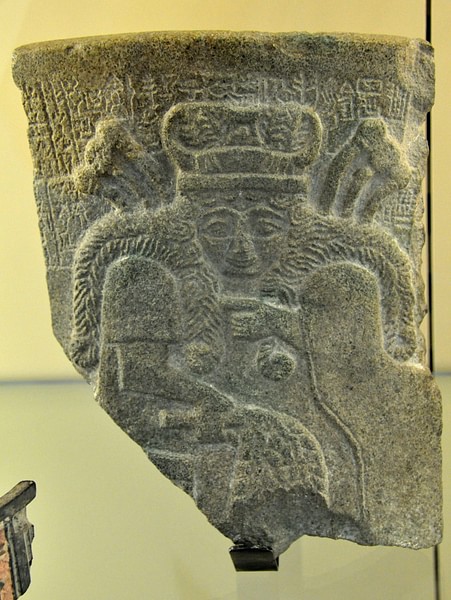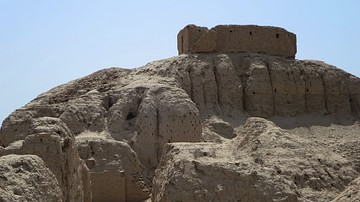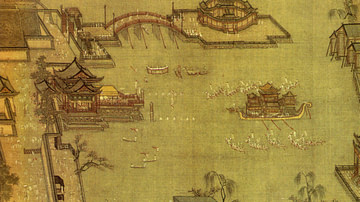The Song of the Hoe is a Sumerian praise poem celebrating the hoe for its many uses and linking it to the creation of the world by the great god Enlil. As the economy of Mesopotamia was almost entirely based on agriculture, it is not surprising to find an agricultural implement as the subject of a hymn of praise.
The poem is dated to c. 2000 BCE and copies were found at Nippur (also known as Nibru), as well as many other locations, beginning in the 19th century through the mid-20th century. Scholars disagree on whether the poem can be defined as a creation myth, though it certainly has elements throughout to suggest this, with some claiming it was probably sung by field hands and farmers in the same way people sing while performing repetitive tasks today: to pass the time while also establishing a rhythm for the work.
This is suggested by the repetition of the word for “hoe” – al – throughout as well as other words and names with al in them. The constant reiteration of al in the original language would have made the song a tongue twister, and so a form of entertainment, while also producing a rhythmic beat. Some scholars, including Jeremy Black, contend it was most likely not sung in fields but in classrooms as part of the educational process during which a student first copied and then recited a work of literature.
Whatever purpose the song served, it was clearly popular as many copies have been found, some with slight or significant differences in some of the lines, but all obviously the same work. The Song of the Hoe remains a favorite in Mesopotamian studies in the present day as it is among the most frequently anthologized; just as it seems to have been over 2000 years ago.
Background
As with almost all of the literature of Mesopotamia, the author of the piece is unknown as is the occasion of its composition. It is dated toward the end of the 3rd millennium BCE with c. 2000 BCE most cited. While scholars disagree on why or precisely when the piece was written, it has been established it was used in the edubba ("House of Tablets"), the scribal schools that produced the literate members of Mesopotamian society.
Students began their education mastering the art of writing cuneiform script and then moved on to copying relatively simple works known as the Tetrad (groups of four compositions) before they were assigned work on the Decad (groups of ten compositions) which was more difficult. The Song of the Hoe was included in the Decad, which a student needed to master before moving on to the more intricate compositions that led to graduation.
Scholar Jeremy Black suggests the repetition of al was a purposeful word game for students who would have been asked to recite it after copying the piece. Black comments:
The Mesopotamian hoe was more like a mattock than a modern garden hoe. Its wide blade was at right angles to the shaft, which meant it could be used like a pick to break up earth, as well as to till and smooth it. As scribal students in Nibru were mostly affluent urbanites destined for careers in temple administration, it is unlikely that any of them would have ever seen the business end of a hoe. The composition should perhaps be seen as at once reminding the young men that the foundations of institutional prosperity rest on manual labor, while distancing them from it through elaborate intellectual word games and clever origin myths. (312)
Rather than a repetitive rhyme for a field hand, Black suggests, the poem was an intricate gauge of how well a student could master the different uses al is put to throughout and would also have served as a form of entertainment as one tried to recite it. Scholar Samuel Noah Kramer contends that the piece is a creation myth but not so much of the world as of the primary implement that enabled the planting of crops and the building of cities. Kramer, in fact, translates the title as "The Creation of the Pickaxe" as the focus of the piece is not on creation per se but on the uses and wonders of the hoe itself.
Summary
Kramer does not deny that the piece was used in the edubba and would most likely agree with Black's conclusion on its purpose. In considering the work as a creation myth, however, he points out that the central 'character' of the work is the hoe, not Enlil or the many other deities named.
The poem begins with Enlil separating the earth from the heavens with his great hoe, described as made of gold and lapis lazuli, and creating a place for humanity. The ancient Anuna gods recognize his work as good and Ninmena (Ninhursag, the Mother Goddess), decrees reproduction (lines 1-27). In line 28, Enlil is referenced by one of his other names, Nunamnir, and Enki, the god of wisdom, praises Enlil's hoe, not Enlil himself, just as the Anuna had praised his work, not him.
The goddess Nisaba, once a grain deity but here associated with her later role as goddess of writing and accounts, is given the task of keeping records, and this is tied to line 34 where the people take up their own hoes and emulate Enlil in the act of creation. Nisaba is therefore seen as a goddess keeping account of people's deeds, not just how much grain was produced or money made.
From lines 35 on, all praise the hoe and its uses. The E-Kur, Enlil's temple, is built by the hoe, and Ninlil (goddess of air and Enlil's consort) and Ninisina (Gula, goddess of health and healing) bring offerings for the lord of the hoe. Enki, referenced by another of his names (Nudimmud), is given the epithet "hoe wielder" in creating the freshwater realm of the Abzu, and in lines 46-48, Ninhursag has Ninurta the war god (given here as Cul-pa-eda) help her in construction of the temple altar. The goddess Inanna, meanwhile, works on her own city with Utu, the sun god, while Nisaba does the same elsewhere (lines 52-58), and in lines 59-70, Inanna's son Sara (also known as Cara) requests the tools that will bring order and, among other implements, is given a hoe.
Humans were understood to be co-workers with the gods in maintaining order, and this concept is illustrated throughout the poem as the gods create and, it is suggested, the humans care for their creation. Even the underworld and divine justice involve themselves in the work of the hoe, as evidenced by the reference to Dumuzid (Dumuzi, an underworld deity) and Gibil, god of fire and the hearth but also of justice. In lines 71-82, the temple of Jectin-ana (Gestiana, Enlil's daughter and goddess of song) rings out as Enlil calls to his hoe while he works.
The hoe's uses in building, in burying the dead, as an agricultural tool, and as a weapon are praised through reference to Nergal, also a god of war and of the underworld, and to the hero Gilgamesh who, "with the hoe, he is the great barber of the watercourses" (line 81), a reference to the hoe in creating irrigation ditches. Lines 83-109 describe the order of things, how everything has its place, and how this is made possible by the hoe, whose destiny was fixed for this purpose by Enlil, the creator god. The work ends, in keeping with tradition, with praise to Nisaba for inspiring and guiding the poet's hand.
The Text
The following passage is taken from The Literature of Ancient Sumer, translated by Jeremy Black et al. Ellipses indicate missing words or sentences and question marks alternative possibilities in translation. The Sumerian words relating to al follow the English word as is customary in translations of this particular piece.
1-7: Not only did the lord make the world appear in its correct form – the lord who never changes the destinies which he determines: Enlil, who will make the human seed of the Land come forth from the earth – and not only did he hasten to separate heaven from earth, and hasten to separate earth from heaven, but, in order to make it possible for humans to grow in 'Where Flesh Came Forth' [the name of a cosmic location], he first suspended the axis of the world at Dur-an-ki.
8-17: He did this with the help of the hoe (al) – and so daylight broke forth (aled). By distributing (altare) the shares of duty he established daily tasks, and for the hoe (al) and the carrying-basket wages were even established. Then Enlil praised his hoe (al), his hoe (al) wrought in gold, its top inlaid with lapis lazuli, his hoe (al) whose blade was tied on with a cord, which was adorned with silver and gold, his hoe (al), the edge of whose point (?) was a plough of lapis lazuli, whose blade was like a battering ram standing up to a great (gal) wall. The lord evaluated the hoe (al), determined its future destiny and placed a holy crown on its head ...
18-27: Here, in Where Flesh Came Forth, he set this very hoe (al) to work; he had it place the first model of mankind in the brick mould. His Land started to break through the soil towards Enlil. He looked with favour at his black-headed people. Now the Anuna gods stepped forward to him and did (jal) obeisance to him. They calmed Enlil with a prayer, for they wanted to demand (al-dug) the black-headed people from him. Ninmena, the lady who had given birth to the ruler, who had given birth to the king, now set (aljaja) human reproduction going.
28-34: The leader of heaven and earth, lord Nunamnir, named the important persons and valued (kal) persons. He ...... these persons, and recruited them to provide for the gods. Now Enki praised Enlil's hoe (al), and the maiden Nisaba was made responsible for keeping records of the decisions. And so people took (jal) the shining hoes (al), the holy hoes (al), into their hands.
35-42: The E-kur, the temple of Enlil, was founded by the hoe (al). By day it was building (aldue) it, by night it caused the temple to grow (almumu). In well-founded Nibru, the hero Ninurta entered into the presence of Enlil in the inner chamber of the Tummal – the Tummal, the bread basket (?) of mother Ninlil – the innermost chamber of the Tummal, with regular food deliveries. Holy Ninisina entered into the presence of Enlil with black kids and fruit offerings for the lord.
43-45: Next comes the Abzu, with the lions before it, where the divine powers may not be requested (al-dug): the hoe wielder (?) (altar), the good man, lord Nudimmud was building (aldue) the Abzu, Eridu having been chosen as the construction site (altar).
46-48: The mother of the gods, Ninhursaja, had the mighty (?) (altar) light of the lord live with her in Kec; she had Cul-pa-eda, no less, help her with the construction work (altar).
49-51: The shrine E-ana was cleaned up by means of the hoe (al) for the lady of E-ana, the good cow (immal). The hoe (al) deals with ruin mounds, the hoe (al) deals with weeds.
52-55: In the city of Zabalam, the hoe (al) is Inana's workman (?). She determined the destiny of the hoe (al), with its projecting lapis-lazuli beard. Utu was ready to help her with her building project (altar); it is the renowned (?) building project (altar) of youthful Utu.
56-58: The lady with broad (dajal) intelligence, Nisaba, ordered the measuring of the E-ana for a construction project (altar), and then designed her own E-hamun for construction (altar).
59-70: The king who measured up the hoe (al) and who passes (zal) his time in its tracks, the hero Ninurta, has introduced working with the hoe (altar) into the rebel (bal) lands. He subdues (aljaja) any city that does not obey its lord. Towards heaven he roars (algigi) like a storm, earthwards he strikes (aljaja) like a dragon (ucumgal). Sara sat down on Enlil's knees, and Enlil gave him what he had desired (al-dug): he had mentioned the mace, the club, arrows and quiver, and the hoe (al). Dumuzid is the one who makes the upper land fertile (allumlum). Gibil made his hoe (al) raise its head towards the heavens – he caused the hoe (al), sacred indeed, to be refined with fire. The Anuna were rejoicing (alhulhuledec).
71-82: The temple of Jectin-ana resembled an aljarsur instrument, the aljarsur of mother Jectin-ana that makes a pleasant sound. The lord [Enlil] bellowed at his hoe (al) like a bull. As for the grave (irigal): the hoe (al) buries people, but dead people are also brought up from the ground by the hoe (al). With the hoe (al), the hero honoured by An, the younger brother of Nergal, the warrior Gilgamesh is as powerful as a hunting net. The son of Ninsumun [Gilgamesh] is pre-eminent with oars (jisal). With the hoe (al) he is the great barber (kindajal) of the watercourses. In the chamber of the shrine, with the hoe (al) he is the minister (sukkal). The wicked (huljal) ... are sons of the hoe (al); they are born in sleep from heaven.
83-93: In the sky there is the altirigu bird, the bird of the god. On the earth there is the hoe (al): a dog in the reed-beds, a dragon (ucumgal) in the forest. On the battlefield, there is the dur-allub battle-axe. By the city wall there is the battle-net (alluhab). On the dining-table there is the bowl (maltum). In the waggon shed, there is the sledge (mayaltum). In the donkey stable there is the cupboard (argibil). The hoe (al)! – the sound of the word is sweet: it also occurs (munjal) on the hillsides: the tree of the hillsides is the allanum oak. The fragrance of the hillsides is the arganum balm. The precious stone of the hillsides is the algamec steatite.
94-106: The hoe (al) makes everything prosper; the hoe makes everything flourish. The hoe (al) is good barley, the hoe (al) is a hunting net. The hoe (al) is brick moulds, the hoe (al) has made people exist (jal). It is the hoe (al) that is the strength of young manhood. The hoe (al) and the basket are the tools for building cities. It builds (aldue) the right kind of house, it cultivates (aljaja) the right kind of fields. It is you, hoe, that extend (dajal) the good agricultural land! The hoe (al) subdues for its owner (lugal) any agricultural lands that have been recalcitrant (bal) against their owner (lugal), any agricultural lands that have not submitted to their owner (lugal). It chops the heads off the vile esparto grasses, yanks them out at their roots, and tears at their stalks. The hoe (al) also subdues (aljaja) the hirin weeds.
107-109: The hoe (al), the implement whose destiny was fixed by Father Enlil – the renowned hoe (al)! Nisaba be praised!
Conclusion
The Mesopotamian hoe would have been a prized possession as it was used daily by most of the population as the primary tool in farming and construction. A praise song to such a vital implement, however odd this may seem to a modern audience, would be comparable to any hymn of thanksgiving sung today in gratitude for what one has been given in life.
The Song of the Hoe links one's own implement to the same wielded at the creation of the world and, in so doing, makes one's work sacred. It is therefore possible, if not likely, that the song was sung by field workers – or at least known by them – who, in carrying out their daily chores, would have been encouraged by the suggestion that they were performing the same task with their hoes as the gods had with their own.







